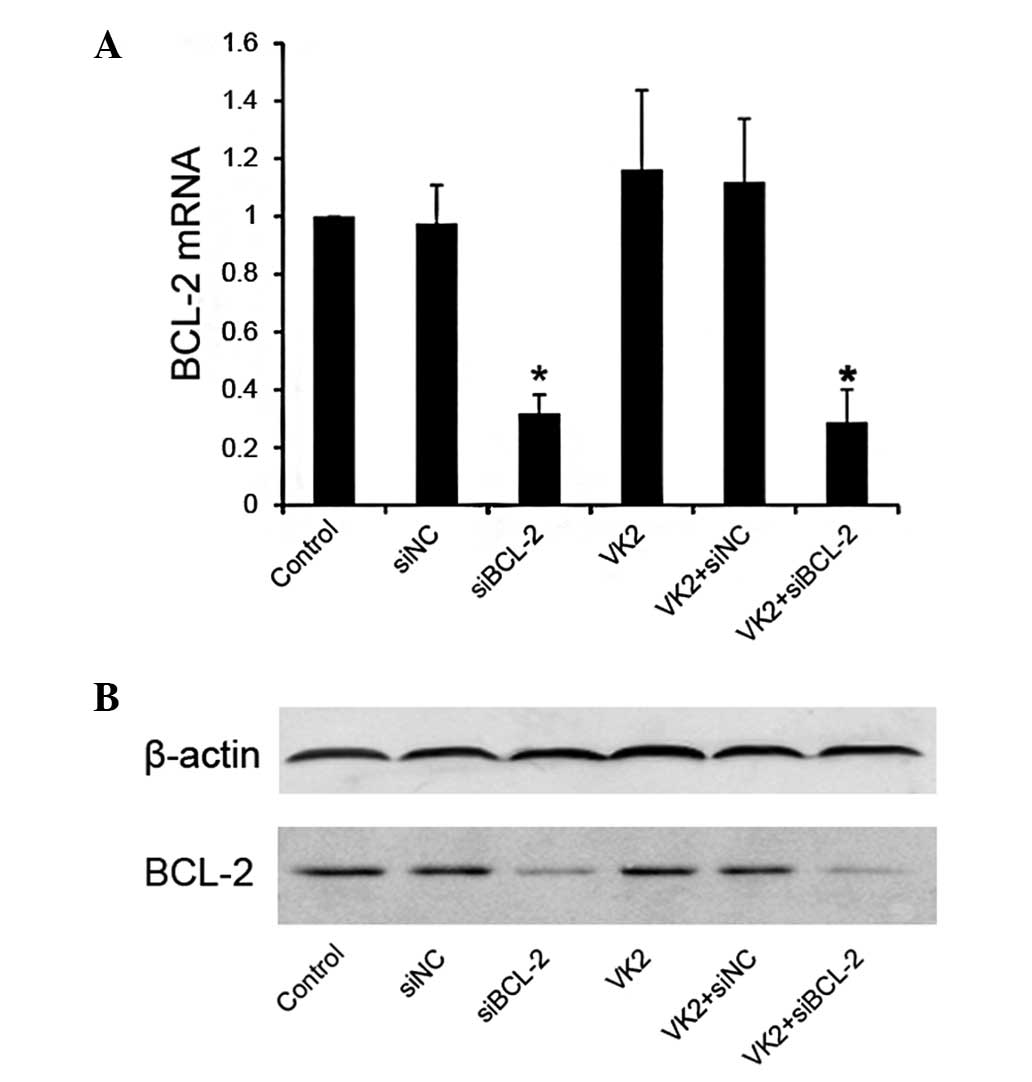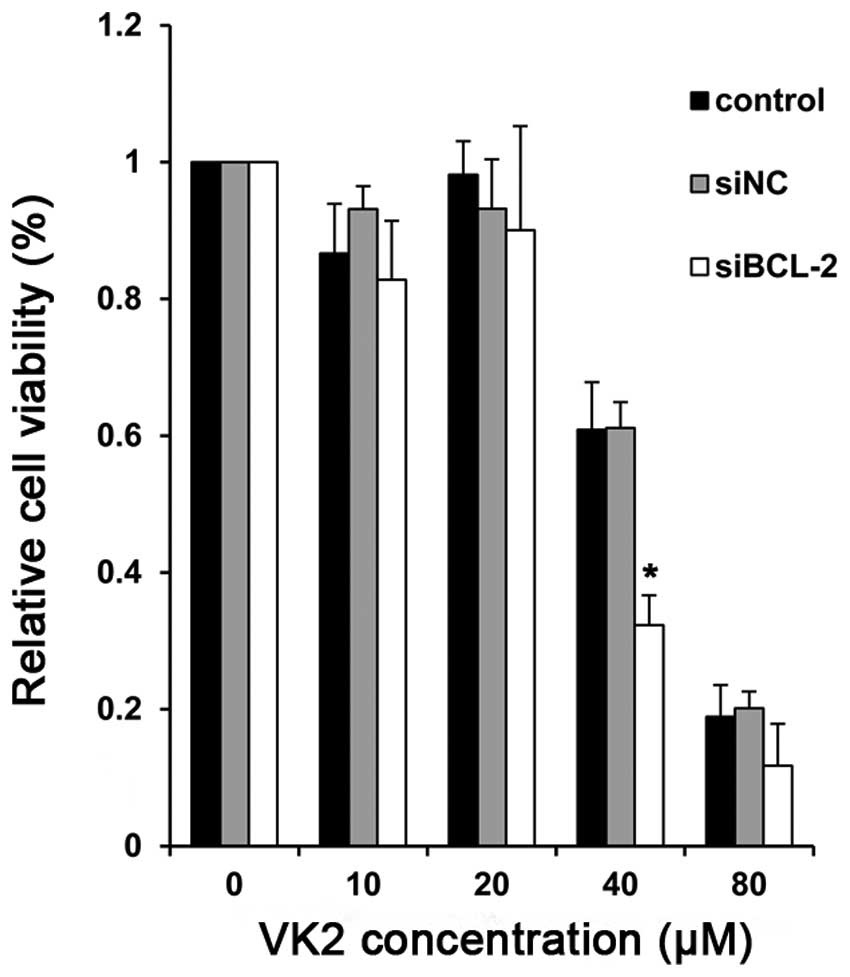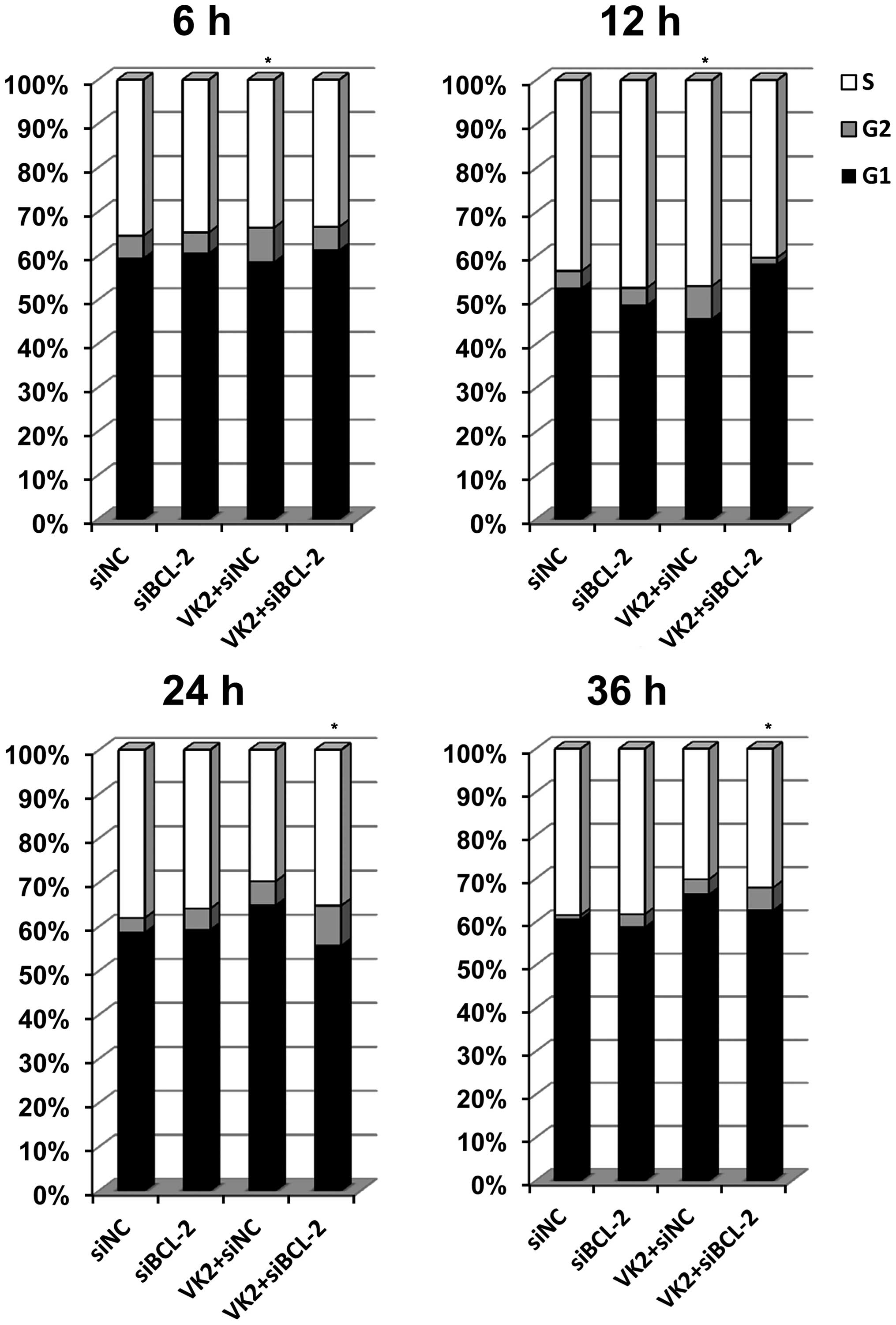|
1
|
Conly JM and Stein K: The production of
menaquinones (vitamin K2) by intestinal bacteria and their role in
maintaining coagulation homeostasis. Prog Food Nutr Sci.
16:307–343. 1992.PubMed/NCBI
|
|
2
|
Shiraki M, Shiraki Y, Aoki C and Miura M:
Vitamin K2 (menatetrenone) effectively prevents fractures and
sustains lumbar bone mineral density in osteoporosis. J Bone Miner
Res. 15:515–521. 2000. View Article : Google Scholar : PubMed/NCBI
|
|
3
|
Li L, Qi Z, Qian J, et al: Induction of
apoptosis in hepatocellular carcinoma Smmc-7721 cells by vitamin
K(2) is associated with p53 and independent of the intrinsic
apoptotic pathway. Mol Cell Biochem. 342:125–131. 2010. View Article : Google Scholar : PubMed/NCBI
|
|
4
|
Meek DW: Tumour suppression by p53: a role
for the DNA damage response? Nat Rev Cancer. 9:714–723.
2009.PubMed/NCBI
|
|
5
|
Smeenk L and Lohrum M: Behind the scenes:
Unravelling the molecular mechanisms of p53 target gene selectivity
(Review). Int J Oncol. 37:1061–1070. 2010.PubMed/NCBI
|
|
6
|
Wu JN, Huang J, Yang J, Tashiro S, Onodera
S and Ikejima T: Caspase inhibition augmented oridonin-induced cell
death in murine fibrosarcoma l929 by enhancing reactive oxygen
species generation. J Pharmacol Sci. 108:32–39. 2008. View Article : Google Scholar : PubMed/NCBI
|
|
7
|
Kim R, Tanabe K, Emi M, Uchida Y and Toge
T: Potential roles of antisense therapy in the molecular targeting
of genes involved in cancer (Review). Int J Oncol. 24:5–17.
2004.PubMed/NCBI
|
|
8
|
Zusman I, Gurevich P, Gurevich E and
Ben-Hur H: The immune system, apoptosis and apoptosis-related
proteins in human ovarian tumors (A review). Int J Oncol.
18:965–972. 2001.PubMed/NCBI
|
|
9
|
Reed JC: Dysregulation of apoptosis in
cancer. J Clin Oncol. 17:2941–2953. 1999.PubMed/NCBI
|
|
10
|
Futami T, Miyagishi M, Seki M and Taira K:
Induction of apoptosis in HeLa cells with siRNA expression vector
targeted against bcl-2. Nucleic Acids Res. (Suppl): 251–252. 2002.
View Article : Google Scholar : PubMed/NCBI
|
|
11
|
Zhang J, Huang S, Zhang H, Wang H, Guo H,
Qian G, Fan X, Lu J, Hoffman AR, Hu JF and Ge S: Targeted knockdown
of Bcl2 in tumor cells using a synthetic TRAIL 3′-UTR microRNA. Int
J Cancer. 126:2229–2239. 2010.PubMed/NCBI
|
|
12
|
Huang SL, Wu Y, Yu H, et al: Inhibition of
Bcl-2 expression by a novel tumor-specific RNA interference system
increases chemosensitivity to 5-fluorouracil in Hela cells. Acta
Pharmacol Sin. 27:242–248. 2006. View Article : Google Scholar : PubMed/NCBI
|
|
13
|
Mihara M, Erster S, Zaika A, et al: p53
has a direct apoptogenic role at the mitochondria. Mol Cell.
11:577–590. 2003. View Article : Google Scholar : PubMed/NCBI
|
|
14
|
Marchenko ND, Zaika A and Moll UM: Death
signal-induced localization of p53 protein to mitochondria. A
potential role in apoptotic signaling. J Biol Chem.
275:16202–16212. 2000. View Article : Google Scholar : PubMed/NCBI
|
|
15
|
Yokoyama T, Miyazawa K, Naito M, et al:
Vitamin K2 induces autophagy and apoptosis simultaneously in
leukemia cells. Autophagy. 4:629–640. 2008. View Article : Google Scholar : PubMed/NCBI
|
|
16
|
Matsumoto K, Okano J, Nagahara T and
Murawaki Y: Apoptosis of liver cancer cells by vitamin K2 and
enhancement by MEK inhibition. Int J Oncol. 29:1501–1508.
2006.PubMed/NCBI
|
|
17
|
Reed JC: Apoptosis-based therapies. Nat
Rev Drug Discov. 1:111–121. 2002. View
Article : Google Scholar
|
|
18
|
Miyazawa K, Yaguchi M, Funato K, et al:
Apoptosis/differentiation-inducing effects of vitamin K2 on HL-60
cells: dichotomous nature of vitamin K2 in leukemia cells.
Leukemia. 15:1111–1117. 2001. View Article : Google Scholar : PubMed/NCBI
|
|
19
|
Zhang H, Wang H, Zhang J, et al: Enhanced
therapeutic efficacy by simultaneously targeting two genetic
defects in tumors. Mol Ther. 17:57–64. 2009. View Article : Google Scholar : PubMed/NCBI
|
|
20
|
Yde CW and Issinger OG: Enhancing
cisplatin sensitivity in MCF-7 human breast cancer cells by
down-regulation of Bcl-2 and cyclin D1. Int J Oncol. 29:1397–1404.
2006.PubMed/NCBI
|
|
21
|
El-Deiry WS, Tokino T, Velculescu VE, et
al: WAF1, a potential mediator of p53 tumor suppression. Cell.
75:817–825. 1993. View Article : Google Scholar : PubMed/NCBI
|
|
22
|
El-Deiry WS, Harper JW, O’Connor PM, et
al: WAF1/CIP1 is induced in p53-mediated G1 arrest and apoptosis.
Cancer Res. 54:1169–1174. 1994.PubMed/NCBI
|
|
23
|
Niculescu AB III, Chen X, Smeets M, Hengst
L, Prives C and Reed SI: Effects of p21(Cip1/Waf1) at both the G1/S
and the G2/M cell cycle transitions: pRb is a critical determinant
in blocking DNA replication and in preventing endoreduplication.
Mol Cell Biol. 18:629–643. 1998.PubMed/NCBI
|
|
24
|
Ogryzko VV, Wong P and Howard BH: WAF1
retards S-phase progression primarily by inhibition of
cyclin-dependent kinases. Mol Cell Biol. 17:4877–4882.
1997.PubMed/NCBI
|
|
25
|
Radhakrishnan SK, Feliciano CS, Najmabadi
F, et al: Constitutive expression of E2F-1 leads to p21-dependent
cell cycle arrest in S phase of the cell cycle. Oncogene.
23:4173–4176. 2004. View Article : Google Scholar : PubMed/NCBI
|
|
26
|
Waldman T, Kinzler KW and Vogelstein B:
p21 is necessary for the p53-mediated G1 arrest in human cancer
cells. Cancer Res. 55:5187–5190. 1995.PubMed/NCBI
|
|
27
|
Bunz F, Dutriaux A, Lengauer C, et al:
Requirement for p53 and p21 to sustain G2 arrest after DNA damage.
Science. 282:1497–1501. 1998. View Article : Google Scholar : PubMed/NCBI
|
|
28
|
Smits VA, Klompmaker R, Arnaud L, Rijksen
G, Nigg EA and Medema RH: Polo-like kinase-1 is a target of the DNA
damage checkpoint. Nat Cell Biol. 2:672–676. 2000. View Article : Google Scholar : PubMed/NCBI
|
|
29
|
Harms KL and Chen X: The C terminus of p53
family proteins is a cell fate determinant. Mol Cell Biol.
25:2014–2030. 2005. View Article : Google Scholar : PubMed/NCBI
|














